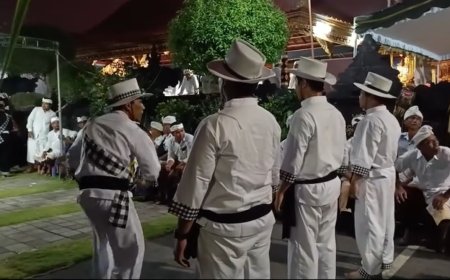Usaba Dangsil: A Captivating Spiritual Ritual in Bungaya Village, Karangasem
Usaba Dangsil, also known as Usaba Gede, is a traditional ceremony held once every ten years in Bungaya Village, Karangasem Regency. This ceremony is conducted as an expression of devotion and gratitude to Ida Sang Hyang Widhi Wasa, with the hope of being granted peace and prosperity for the community, as well as abundant agricultural yields.

Usaba Dangsil is a traditional ceremony that has existed since 1665-1685 during the reign of Dalem Demade, led by I Gusti Ngurah Alit Bungaya. As part of this tradition, Dalem Demade gifted 108 plots of rice fields to the people of Bungaya to support the ceremony.
Usaba Dangsil derives from two words: Usaba meaning ceremony, and Dangsil referring to a tower made from various leaves and fruits. Usaba Dangsil is renowned for the use of "dangsil" as its main element, which consists of offerings arranged from different leaves, local snacks, and tiered offerings resembling a mountain. A unique aspect of Usaba Dangsil is that the ceremony is performed by the alon Deha (young women) and Teruna (young men), with an indeterminate duration.
Initially, Usaba Dangsil was held every two years however, due to the high costs involved, the tradition is now celebrated every ten years, though the exact date is yet to be determined. This scheduling also depends on the availability of funds and the decreasing number of Dehe in Bungaya Village.
-Dangsil Dalem, the highest tier with 11 levels, approximately 16 meters tall
-Dangsil Desa, with 9 levels
-Dangsil Subak, consisting of 4 pieces with 7 levels each
-Dangsil with 5 levels
-Small Dangsil, 3 levels, totaling 40 pieces

Carrying of the Dangsil (Photo Source: Personal Collection)
The series of Usaba Dangsil activities is divided into four stages: Melasti, Mesesedep, Tarian Anda, and the Puncak Upacara (Peak Ceremony). Overall, this ceremonial series lasts about two months. Here are some of the ceremonial sequences of Usaba Dan
1. Melasti is the purification process for all pratima conducted at Pasir Putih Beach, Desa Perasi, and is participated in by the entire community. Men are not allowed to wear shirts or udeng (headbands), and can only wear kamben and patterned saput. Meanwhile, candidates for Deha and Teruna must fast from morning until the completion of melasti.
2. Mesesedep is specifically held for candidates of Deha and Teruna to ensure they are truly pure in body and mind, ready to follow the subsequent ceremonial stages.
3. Tarian Anda is a sacred dance performed by Deha, Teruna, and village elders. This dance begins at Pura Penataran in the early morning, followed by Tarian Anda Gede at the Pura Puseh (Bale Agung) courtyard. The Tarian Anda procession is highly sacred, with several prohibitions, such as not breaking the line of dancers. This activity runs from 7:00 PM WITA until dawn, alternating between Deha and Teruna in special clothing. After dancing, they sit in order at Bale Agung. The Tarian Anda can last until morning or even longer, as participants form a circle and perform a collective dance for 81 rounds, taking about 7 hours. This serves as mental and physical training for the Teruna and Deha to remain strong and resilient.
4. Puncak Upacara is the procession where the dangsil that has been erected at each pura is carried to Pura Penataran. The Dangsil Dalem is ascended by the descendants of the Raja Klungkung, reflecting the historical ties between Bungaya Village and Raja Klungkung. A unique aspect of the Usaba Dangsil peak ceremony is the dress code, where all participants are prohibited from wearing shirts. Men wear only kamben and saput without udeng, while women wear kamben and torso (breast cover).

Carrying of the Jempana (Photo Source: Personal Collection)
Usaba Dangsil embodies complex values, including cultural significance, where the customs and traditions reflected in its execution form the cultural identity of the region, passed down through generations. Each procession is conducted with strict adherence to tradition. Additionally, there is a sense of brotherhood or solidarity evident throughout each ceremony, involving not only the people of Bungaya but also support from neighboring villages.
Efforts made by the community and the Prajuru Adat to ensure the sustainability of Usaba Dangsil include a commitment to hold the ceremony every ten years. The community actively participates in Usaba Dangsil with order and reverence, and is willing to engage in ngayah (volunteering) for the ceremony's execution. Furthermore, the arrangement of Usaba Dangsil activities and all necessary facilities have been documented by the Prajuru Desa Adat and the Penyarikan Dehe/Teruna of Bungaya Village.































































